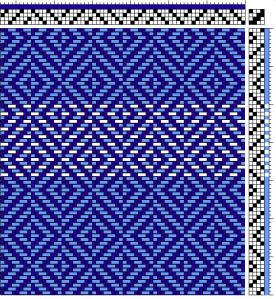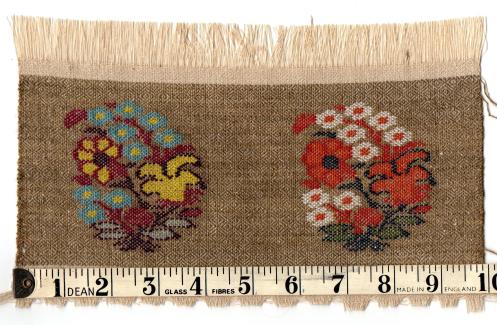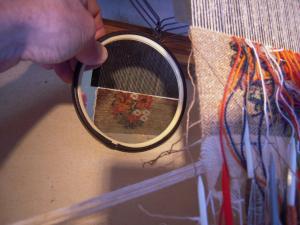Chashm-i-bulbul and kani weaving
I have had an abiding interest in the question, What other weave patterns might be combined with talim-based tapestry designs? ever since I learned that representing these designs on a computer-screen grid was one thing and transferring them to weaving – or stitchery, or beadwork or knitting – was another. Kani weaving is traditionally done on what I know as straight 2/2 twill, on a 4-shaft counterbalance loom. Each weft pick is a regular succession of  over-2-under-2 stitches, that can be represented by units on a grid, and given to the weaver as pick-by-pick, step-by-step instructions in the talim. In kani weaving, usually either 2 picks or 4 picks are woven to the same talim line. On the computer screen these two variations can be represented by a brick-grid or square-grid format, respectively. To refine my initial question: What weave patterns will provide a regular correspondence between the raised warps presented on the loom and the grid-units of the design instructions?
over-2-under-2 stitches, that can be represented by units on a grid, and given to the weaver as pick-by-pick, step-by-step instructions in the talim. In kani weaving, usually either 2 picks or 4 picks are woven to the same talim line. On the computer screen these two variations can be represented by a brick-grid or square-grid format, respectively. To refine my initial question: What weave patterns will provide a regular correspondence between the raised warps presented on the loom and the grid-units of the design instructions?
 Early experiments were encouraging: I found undulating twill and broken twill patterns that could be worked on an existing 4-shaft, straight twill threading.
Early experiments were encouraging: I found undulating twill and broken twill patterns that could be worked on an existing 4-shaft, straight twill threading.
Each grid unit of design corresponded to the placement of stitches in each pick, but the difference in weave pattern was also visible.
 Chashm-i-bulbul – “nightingale’s eye” – is a favourite traditional pattern in Kashmir for fine loom-woven shawl fabric. A kind of “bird’s-eye twill” of concentric diamond shapes, it is accomplished with a broken point-twill threading on 4 shafts and a reversing sequence in the treadling cycle. At first glance, the weaving draw-down presents varying numbers and groups of stitches in each pick, over and under 1 warp or 2… problematic to co-ordinate with a regular arrangement of design grid-units.
Chashm-i-bulbul – “nightingale’s eye” – is a favourite traditional pattern in Kashmir for fine loom-woven shawl fabric. A kind of “bird’s-eye twill” of concentric diamond shapes, it is accomplished with a broken point-twill threading on 4 shafts and a reversing sequence in the treadling cycle. At first glance, the weaving draw-down presents varying numbers and groups of stitches in each pick, over and under 1 warp or 2… problematic to co-ordinate with a regular arrangement of design grid-units.

More recently looking again at the draw-down, I realised that every second pick was a regular over-2-under-2 succession of stitches – all the weave-pattern connections, the points on those little diamonds, were expressed in the alternate picks, that could be shuttle-woven. All in all, the grid-units of the tapestry design could be co-ordinated with the over-2-under-2 stitches, the alternate picks shuttle-woven as ground wefts, and the tapestry wefts passed over the intervening pick on the working side as they often are.
Chashm-i-bulbul is a balanced weave, the same number of warps and wefts per measurement. If each over-2-under-2 stitch, corresponds to one grid-unit or one nal of a traditional talim, then 4 picks altogether corresponds to one row of square-grid units or two rows of brick-grid units. Two of those picks are shuttle-woven background. So, a talim line ordinarily repeated in 4 picks is woven only twice, and a talim line in the 2-picks-per-talim-line format is woven only once – the return pick will be the next talim line.
 The routine is much like simply weaving kani-style, except for the alternation of kani picks and shuttle picks. I’m using a chashm-i-bulbul treadling cycle of 20 picks, which I think of as 5 groups of 4 picks. In each group the first pick is kani wefts going L-to-R; second pick is a shuttle pick L-to-R; third pick is kani R-to-L; fourth pick is shuttle R-to-L. For the first pick I just have to choose a treadling that shows the warps 2-up-2-down; after that they will come up automatically.
The routine is much like simply weaving kani-style, except for the alternation of kani picks and shuttle picks. I’m using a chashm-i-bulbul treadling cycle of 20 picks, which I think of as 5 groups of 4 picks. In each group the first pick is kani wefts going L-to-R; second pick is a shuttle pick L-to-R; third pick is kani R-to-L; fourth pick is shuttle R-to-L. For the first pick I just have to choose a treadling that shows the warps 2-up-2-down; after that they will come up automatically.
So in each cycle of 20 picks, there is 10 picks of kani weaving – each pick different if it’s a brick-grid design or 5 talim lines woven twice each if it’s a square-grid design. Knowing where I am in the design makes it easier to not lose my place in the chashm-i-bulbul treadling. All those shuttle picks help to weave up faster, and make the fabric width more stable than if it were all tapestry.
Next time I’ll discuss my succession of samples that kept me company in the summer of the pandemic.





Wow peter, I’ve just discovered your blog and I’m quite fascinated by your work. I’m doing research on the construction and especially the design of kashmir shawls. Your blog has been an immense resource of practical knowledge and source material to investigate.
A second, less frequently seen weave done only on pashmina, covers the surface with tiny lozenge shaped squares, earning it the delightful name of ‘chashm-e-bulbul,’ or eye of the bulbul . As this weave is a masterpiece of the weaver’s art, it is normally not embroidered upon. Shahtoosh, from which the legendary ‘ring shawl’ is made, is incredibly light, soft and warm. The astronomical price it commands in the market is due to the scarcity of the raw material. High in the plateaux of Tibet and the eastern part of Ladakh, at an altitude of above 5,000 m, roam the Tibetan antelope (Pantholops Hodgsoni). During grazing, a few strands of the downy hair from the throat are shed which are painstakingly collected by the nomads, eventually to supply to the Kashmiri shawl makers as shahtoosh.